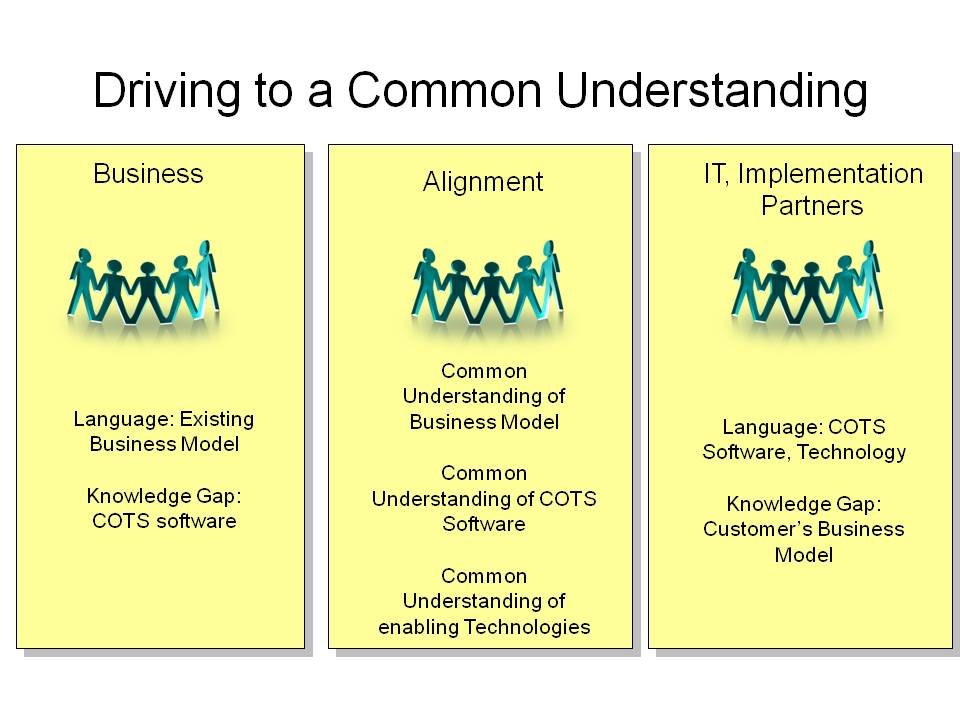You’ve decided on the ERP software you need, the Business side has bought into it, and you’ve even picked your Implementation Partner. Now the hard work begins: Making sure that your software deployment strategy sets your company up for success, and that means making sure Business, IT and the Implementation Partner are all speaking the same language.

First, we need to understand that Business, IT, and the Implementation Partner are coming from different perspectives. Every party has a knowledge gap to address. Business best understands their existing business model and the underlying success drivers. The Implementation Partner understands the ERP software and has multiple years of implementation experience. IT best understands how technology supports the existing business model as well as how best to utilize existing corporate IT technologies. Alignment is generated only when a common understand of the business model, ERP software, and technology capabilities are shared by all three parties. When this alignment occurs there is effective communications and faster decision-making. Decisions move implementations forward.
Following is a recommended set of steps to develop a common understanding for effective collaboration:
- Document existing business processes
It is an area that I see many ERP implementations lack. The typical challenge I hear is “Why document my existing business processes if I know they are changing?” Here are my reasons:
- Business users usually do not have a consistent understanding of their business model. Going through the exercise of documenting business process will highlight these differences and drive deeper understanding.
- Documenting the existing business model will enable you to highlight the EXACT organizational changes that will occur. How can you manage organizational change when you do not have a clear understanding of what’s changing?
- Business process maps can be a key source of information to quickly educate IT and the Implementation Partner on the existing business process model.
- Educate IT and the Implementation Partner on the existing business model
Business should take a formal, iterative process to educate IT and the Implementation Partner on the existing business model. The entire project team should be involved in this training and should progress from a solution-level overview to a detailed business-role level. Following is a suggested approach for conducting this training:
| Level | Description | Suggested Duration |
| Business Solution | Provide an executive overview of the existing business processes, systems, and organizations that make up the existing business solution. | 4 hours |
| Business Process | Provide a work flow of business activities that result from a business event. Key variations and exceptions should be noted. | 2 hours for each business process |
| Business Activities grouped by Role | Provide a “day in the life” experience for key roles that support the business solution. | 1 hour for each role |
- Complete ERP software training BEFORE the Implementation Partner arrives
Just as it is important for your Implementation Partner to understand your business model and your language it is important that Business and IT have an understanding of the ERP software and its language. Effective communication is a two party effort. Taking the required ERP training before the arrival of your Implementation Partner will enable you to more effectively work together.
- Have the Implementation Partner conduct supplemental ERP software training
Education is an iterative process – you will never learn everything you need to know for supporting ERP in one training class. ERP vendors only provide foundational training. I always say that the Implementation Partner completes ERP training for the customer. Implementation Partners have hands-on experience with configuration and maintenance of ERP solutions.
- Implementation documentation should be more business-oriented
Nothing encourages alignment more than being able to think like your end customer. Too often we create project documentation that focuses more on technology than business reasoning and justification. There are times were I am guilty of moving too quickly from what needs to be done to how will it be done without understanding why does it need to be done. At the end of the day we build software to drive business results.
Summary
Business to IT alignment is a strategic goal that can only be reached by taking tactical steps to bring Business and IT closer together to generate mutual understanding and trust. Implementing ERP software is an opportunity to generate greater alignment by developing a common language for effective collaboration. When alignment is achieved then decision-making is effective resulting in a greater opportunity for success.
From the book “Maximize Your Investment: 10 Key Strategies for Effective Packaged Software Implementations” by Brett Beaubouef.
Join the community! 10k followers across 100 countries!


Leave a Reply